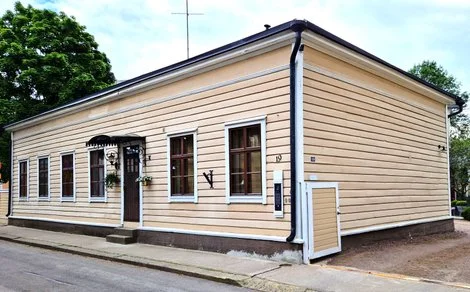
Borgman’s House

Borgman’s House
The general appearance of the property has remained remarkably similar for the past couple of centuries. Earlier buildings on the site were likely destroyed in the great fires of 1821 and 1840, but the current buildings on this plot were spared during the great fire of 1887.
In 1790, the plot was owned by Vasili Kiselev (Kiseleff), a burgher of Russian descent who also owned a brickworks near Mullinkoski. Another part of the plot was owned by the widow of Staff Surgeon Griin (Gryn). Between 1832 and 1872, the property was home to master carpenter Anders Borgman and his family. In 1872, the plot passed to City Bailiff Esaias Niemelä (1810–1886), and later to his son, agronomist and economic counselor Esaias Evert Niemelä (1873–1951). In 1982, the property returned to the same family, as the current owner’s wife is a direct descendant of the aforementioned family (Esaias being her great-grandfather, and Esaias Evert her grandfather).
The current main building dates back to 1848. The plot also includes a vaulted cellar from the 1700s. Over the years, both the main and side buildings have undergone changes—for example, the locations of the windows and doors in the main building have been altered.
The previous building on the site was constructed in 1822 (and destroyed in the 1840 fire). It was painted with green oil paint and featured an entry porch, one larger and one smaller salon, five chambers, two kitchens, and a storage room. Each window frame had four panes, and the house had four chimneys. Additionally, the plot contained a side building built in 1824, a cellar, baking house, stable, woodshed, shed, animal shelter, tool shed, and outhouse.
Small glimpses of history are still present: a maker’s stamp in a floor tile of the old vaulted cellar, a Swedish copper coin from the 1700s found in the yard, and a rare 18th-century bronze ring with a domed monogram.

